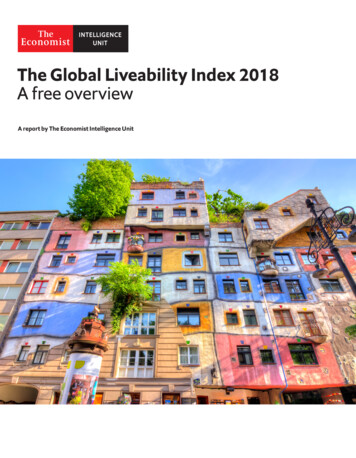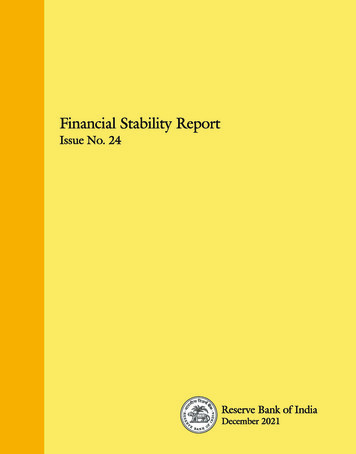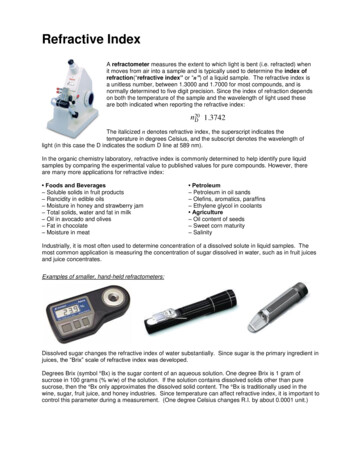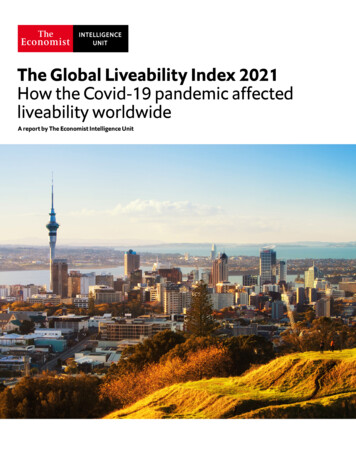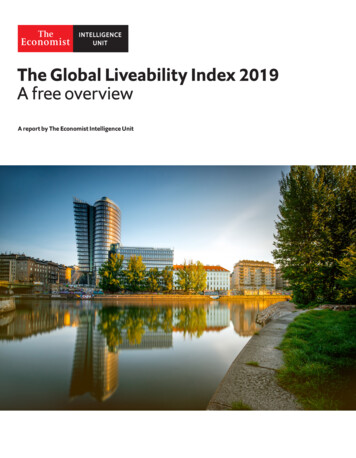
Transcription
The Global Liveability Index 2019A free overviewA report by The Economist Intelligence Unit
The world leader in global business intelligenceThe Economist Intelligence Unit (The EIU) is the research and analysis division of The Economist Group, the sister companyto The Economist newspaper. Created in 1946, we have over 70 years’ experience in helping businesses, financial firms andgovernments to understand how the world is changing and how that creates opportunities to be seized and risks to be managed.Given that many of the issues facing the world have an international (if not global) dimension, The EIU is ideally positioned to becommentator, interpreter and forecaster on the phenomenon of globalisation as it gathers pace and impact.EIU subscription servicesThe world’s leading organisations rely on our subscription services for data, analysis and forecasts to keep them informed aboutwhat is happening around the world. We specialise in: C ountry Analysis: Access to regular, detailed country-specific economic and political forecasts, as well as assessments ofthe business and regulatory environments in different markets. R isk Analysis: Our risk services identify actual and potential threats around the world and help our clients understand theimplications for their organisations. I ndustry Analysis: Five year forecasts, analysis of key themes and news analysis for six key industries in 60 majoreconomies. These forecasts are based on the latest data and in-depth analysis of industry trends.EIU ConsultingEIU Consulting is a bespoke service designed to provide solutions specific to our customers’ needs. We specialise in these keysectors: H ealthcare: Together with our two specialised consultancies, Bazian and Clearstate, The EIU helps healthcare organisationsbuild and maintain successful and sustainable businesses across the healthcare ecosystem. Find out more at: eiu.com/healthcare P ublic Policy: Trusted by the sector’s most influential stakeholders, our global public policy practice provides evidencebased research for policy-makers and stakeholders seeking clear and measurable outcomes. Find out more at: eiu.com/publicpolicyThe Economist Corporate NetworkThe Economist Corporate Network (ECN) is The Economist Group’s advisory service for organisational leaders seeking to betterunderstand the economic and business environments of global markets. Delivering independent, thought-provoking content,ECN provides clients with the knowledge, insight, and interaction that support better-informed strategies and decisions.The Network is part of The Economist Intelligence Unit and is led by experts with in-depth understanding of the geographies andmarkets they oversee. The Network’s membership-based operations cover Asia-Pacific, the Middle East, and Africa. Through adistinctive blend of interactive conferences, specially designed events, C-suite discussions, member briefings, and high-calibreresearch, The Economist Corporate Network delivers a range of macro (global, regional, national, and territorial) as well asindustry-focused analysis on prevailing conditions and forecast trends.
THE GLOBAL LIVEABILITY INDEX 2019A FREE OVERVIEWContentsThe findings of the latest liveability survey 2Vienna remains the most liveable city in the world, just ahead of Melbourne 21About The Economist Intelligence Unit’s liveability survey 5How the rating works 5The suggested liveability scale 5How the rating is calculated 5 The Economist Intelligence Unit Limited 2019
THE GLOBAL LIVEABILITY INDEX 2019A FREE OVERVIEWThe findings of the latest liveability surveyVienna remains the most liveable city in the world, justahead of MelbourneVienna remains the most liveable of the 140 cities surveyed by The Economist Intelligence Unit. Afterdisplacing Melbourne from the top spot in 2018, ending a record run of seven consecutive years, Viennaretained its position at the head of the survey in 2019. The two cities continue to be separated by 0.7percentage points, with Vienna scoring 99.1 out of 100 and Melbourne 98.4.Two other Australian cities feature in the top ten: Sydney (in third) and Adelaide (tenth), while onlyone other European city, Copenhagen in Denmark (ninth), scores among the best. The other topranked cities are split between Japan (Osaka in fourth and Tokyo in joint seventh) and Canada (Calgaryin fifth, and Vancouver and Toronto in sixth and joint seventh, respectively).The cities within the top ten remain unchanged from our previous update, but there has been somemovement in their ranking. Sydney has risen from fifth to third, thanks to an improvement in its cultureand environment score, reflecting an increased focus on combating and mitigating the impacts ofclimate change, as outlined by the city’s “Sustainable Sydney 2030” strategy. However, Sydney remainsbehind its great rival, Melbourne. With both cities already scoring very highly across all categories, thereis only limited potential for Sydney to displace either Melbourne or Vienna at the top of the rankings.No other city in the top ten saw a change to its score.Over the past year we have observed that average scores for stability have risen, reflecting, in verygeneral terms, a slight diminishing of the perceived threat of terrorism, after a period of acute concern.Some of these improvements have been considerable but from a very low base (such as Tripoli in Libyaand Jakarta in Indonesia), while others have seen smaller improvements to already acceptable scores(such as Seattle and Houston in the US, and Seoul in South Korea). Paris in France is the highest rankedcity to have seen a deterioration in its stability score, owing to the ongoing anti-government giletsjaunes protests that began in late 2018. In the emerging world, the Easter Sunday bombings in Sri Lankatriggered a downgrade for Colombo, while the growing instability between the US and Iran was behinda reduction in the stability score for Tehran.Among the other categories, a deterioration in culture and environment scores is of concern. Aslew of cities in emerging markets that are among the most exposed to the effects of climate changehave seen their scores downgraded. These include New Delhi in India, which suffers from appallingair quality, Cairo in Egypt (where air quality is also a major issue) and Dhaka in Bangladesh. A lack ofa concerted global effort to tackle climate change risks further downward revisions in these scores,threatening to offset improvements in the other categories, such as education and infrastructure,which remain on a broadly upward trend.Despite the risk to future scores posed by climate change, a longer-term view suggests that overallliveability has been improving in recent years. In our sample of global cities, the average liveability scorehas increased by 0.5 percentage points, to just under 76, over the past five years, driven primarily byhigher scores in the stability category. Devastating terrorist attacks in New Zealand and Sri Lanka in thepast year are a reminder that threats to security are still apparent, but perceptions of the danger posedby terrorism have diminished in recent years.2 The Economist Intelligence Unit Limited 2019
THE GLOBAL LIVEABILITY INDEX 2019A FREE OVERVIEWAmong the 56 cities that have registered improvements to their overall liveability rankings overthe past five years, four cities stand out. Abidjan in Côte d’Ivoire, Hanoi in Vietnam, Kiev in Ukraineand Belgrade in Serbia have seen increases of 5 percentage points or more. In the last 12 monthsBelgrade has jumped further up the index, from 82nd place to 77th, as a result of upgrades to itsinfrastructure and healthcare scores; it is now mid-ranked among cities in Eastern Europe. Hanoi hasseen improvements almost across the board this year, with higher stability, culture, education andinfrastructure scores. However, in a diverse region, it remains in the bottom third of Asian cities.Following largely peaceful and democratic presidential and parliamentary elections in Ukraine in2019, we have upgraded Kiev’s stability rating relative to a year ago, enabling a small rise in its ranking;however, the legacy impact of the city’s previously low stability scores (due to the ongoing conflictwith Russian-backed rebels in eastern Ukraine) continues to weigh on Kiev’s overall ranking. Finally,Abidjan’s upward trajectory has stalled in the past year, but Côte d’Ivoire’s diversifying economy andstrengthening governance have driven upgrades in previous years.Conflict and economic crisis define the cities that have struggled in our index over the past year. Wehave downgraded scores in four of the five categories for Caracas in Venezuela, as the government’sfight for legitimacy has impeded its ability to provide basic services for its citizens. Its stability scorehas not moved, but only because it was very low a year ago. The effect has been to pull the city downanother five places in the index, to 131st place. New Delhi has also fallen down the index because ofdowngrades not just to its culture and environment score, but also stability, owing to rising crime rates.Detroit in the US is another city that continues to struggle, with major depopulation and urban decayresulting in a high incidence of crime, a collapse in local government tax revenue, swathes of vacanthomes and inadequate infrastructure.Overall, our index remains dominated by medium-sized cities in wealthy countries. These citieshave well-funded public healthcare systems, compulsory and high-quality education, and functionalroad and rail infrastructure. The provision of these services is assisted by the presence of fullydemocratic electoral systems and generally low levels of corruption. The presence of Tokyo in the topten demonstrates that it is possible to scale up these characteristics, but maintaining these levels ofperformance in cities with two, three or four times as many people is challenging, especially whensuch cities also tend to be greater magnets for crime and terrorism. This is why other large “global”cities in advanced economies, such as London and New York, score lower than Vienna and Melbourne(and Tokyo) for stability and infrastructure but are able to match (or exceed) them for culture andenvironment.We note the continued gradual improvement of cities in emerging markets in infrastructure,education and healthcare, as well as, in many cases, stability. However, these gains appear to be comingunder threat from the effects of climate change, which in the index is reflected in the culture andenvironment category. The incidence of extreme weather events, such as flooding and heatwaves,is rising around the world, and cities in emerging markets are often the most directly affected andthe least resilient. That said, we see climate change as a global phenomenon, which threatens theliveability of cities at the very top of the index too. Only a co-ordinated global effort to limit the risingtemperature of the planet will succeed in maintaining current levels of liveability across the world.3 The Economist Intelligence Unit Limited 2019
THE GLOBAL LIVEABILITY INDEX 2019A FREE OVERVIEWFive biggest improvers (last five years)CityCountryRank (out of 140)Overall rating(100 ideal)Five-year Côte d’Ivoire12352.26.3Five biggest decliners (last five years)Overall ratingCityCountryRank (out of 140)Five-year -4.4TripoliLibya13740.4-3.8(100 ideal)The ten most liveable citiesCountryCityRankOverall Rating(100 ideal)StabilityHealthcareCulture raliaAdelaide1096.69510094.210096.4The ten least liveable citiesCountryCityRankOverall Rating(100 ideal)StabilityHealthcareCulture mbabweHarare13442.64020.858.666.735.7PNGPort 29.240.533.332.14 The Economist Intelligence Unit Limited 2019
THE GLOBAL LIVEABILITY INDEX 2019A FREE OVERVIEWAbout The Economist Intelligence Unit’sliveability surveyHow the rating worksThe concept of liveability is simple: it assesses which locations around the world provide the best or theworst living conditions. Assessing liveability has a broad range of uses, from benchmarking perceptionsof development levels to assigning a hardship allowance as part of expatriate relocation packages. Ourliveability rating quantifies the challenges that might be presented to an individual’s lifestyle in anygiven location, and allows for direct comparison between locations.Every city is assigned a rating of relative comfort for over 30 qualitative and quantitative factorsacross five broad categories: stability, healthcare, culture and environment, education, andinfrastructure. Each factor in a city is rated as acceptable, tolerable, uncomfortable, undesirable orintolerable. For qualitative indicators, a rating is awarded based on the judgment of in-house analystsand in-city contributors. For quantitative indicators, a rating is calculated based on the relativeperformance of a number of external data points.The scores are then compiled and weighted to provide a score of 1–100, where 1 is consideredintolerable and 100 is considered ideal. The liveability rating is provided both as an overall score and as ascore for each category. To provide points of reference, the score is also given for each category relativeto New York and an overall position in the ranking of 140 cities is provided.The suggested liveability scaleCompanies pay a premium (usually a percentage of a salary) to employees who move to cities whereliving conditions are particularly difficult and there is excessive physical hardship or a notably unhealthyenvironment.We have given a suggested allowance to correspond with the rating. However, the actual level of theallowance is often a matter of company policy. It is not uncommon, for example, for companies to payhigher allowances—perhaps up to double our suggested level.RatingDescription80-100There are few, if any, challenges to living standardsSuggested allowance (%)70-80Day–to–day living is fine, in general, but some aspects of life may entail problems560-70Negative factors have an impact on day-to-day living1050-60Liveability is substantially constrained1550 or lessMost aspects of living are severely restricted200How the rating is calculatedThe liveability score is reached through category weights, which are equally divided into relevantsubcategories to ensure that the score covers as many indicators as possible. Indicators are scored asacceptable, tolerable, uncomfortable, undesirable or intolerable. These are then weighted to produce arating, where 100 means that liveability in a city is ideal and 1 means that it is intolerable.5 The Economist Intelligence Unit Limited 2019
THE GLOBAL LIVEABILITY INDEX 2019A FREE OVERVIEWFor qualitative variables, an “EIU rating” is awarded based on the judgement of in-house expertcountry analysts and a field correspondent based in each city. For quantitative variables, a rating iscalculated based on the relative performance of a location using external data sources.Category 1: Stability (weight: 25% of total)IndicatorSourcePrevalence of petty crimeEIU ratingPrevalence of violent crimeEIU ratingThreat of terrorEIU ratingThreat of military conflictEIU ratingThreat of civil unrest/conflictEIU ratingCategory 2: Healthcare (weight: 20% of total)IndicatorSourceAvailability of private healthcareEIU ratingQuality of private healthcareEIU ratingAvailability of public healthcareEIU ratingQuality of public healthcareEIU ratingAvailability of over-the-counter drugsEIU ratingGeneral healthcare indicatorsAdapted from World BankCategory 3: Culture & Environment (weight: 25% of total)IndicatorSourceHumidity/temperature ratingAdapted from average weather conditionsDiscomfort of climate to travellersEIU ratingLevel of corruptionAdapted from Transparency InternationalSocial or religious restrictionsEIU ratingLevel of censorshipEIU ratingSporting availabilityEIU field rating of 3 sport indicatorsCultural availabilityEIU field rating of 4 cultural indicatorsFood & drinkEIU field rating of 4 cultural indicatorsConsumer goods & servicesEIU rating of product availabilityCategory 4: Education (weight: 10% of total)IndicatorSourceAvailability of private educationEIU ratingQuality of private educationEIU ratingPublic education indicatorsAdapted from World BankCategory 5: Infrastructure (weight: 20% of total)6IndicatorSourceQuality of road networkEIU ratingQuality of public transportEIU ratingQuality of international linksEIU ratingAvailability of good quality housingEIU ratingQuality of energy provisionEIU ratingQuality of water provisionEIU ratingQuality of telecommunicationsEIU rating The Economist Intelligence Unit Limited 2019
Liveability products available to purchase from The EIUThe Liveability SurveyThe Liveability Survey provides a full report of The EIU’s liveability ratings for 140 cities around the world.This includes a one-page overview for each of the 140 cities covered as well as The EIU’s ratings for eachcity on the full set of over 30 qualitative and quantitative factors. In this ranking: Each of the 30 factors in each city is rated as acceptable, tolerable, uncomfortable, undesirable orintolerable. The categories are compiled and weighted to provide an overall rating of 1–100, where 1 is consideredintolerable and 100 is considered ideal. The liveability ranking considers that any city with a rating of 80 or more will have few, if any,challenges to living standards. Any city with a score of less than 50 will see most aspects of livingseverely restricted.Purchase the Liveability Survey.Liveability Ranking and OverviewThis report provides a complete overview of The EIU’s liveability ratings for 140 cities around the world.This includes: A summary of findings and a description of the methodology used. Tables listing the ranking position, overall liveability score and average scores for all cities across eachof the five categories: stability, healthcare, culture and environment, education and infrastructure.Purchase the Liveability Ranking and Overview.Liveability MatrixThe Liveability Matrix is an interactive Excel workbook that ranks all 140 cities on over 30 qualitative andquantitative factors across the five categories.Purchase the Liveability Matrix.Related ReportsWorldwide Cost of LivingThe Worldwide Cost of Living Survey contains a ranking of 133 cities on their relative expensiveness, basedon a survey which compares more than 400 individual prices across 160 products and services. In additionto the ranking table, the report looks at the key trends affecting the cost of living in different cities acrossthe world.Find out more at: eiu.com/wcol7 The Economist Intelligence Unit Limited 2019
Copyright 2019 The Economist Intelligence Unit Limited. Allrights reserved. Neither this publication nor any partof it may be reproduced, stored in a retrieval system, ortransmitted in any form or by any means, electronic,mechanical, photocopying, recording or otherwise,without the prior permission of The EconomistIntelligence Unit Limited.While every effort has been taken to verify theaccuracy of this information, The EconomistIntelligence Unit Ltd. cannot accept anyresponsibility or liability for reliance by any personon this report or any of the information, opinionsor conclusions set out in this report.Cover image - RossHelen/Shutterstock
LONDON20 Cabot SquareLondonE14 4QWUnited KingdomTel: 44 (0) 20 7576 8181Email: london@eiu.comNEW YORK750 Third Avenue5th FloorNew York, NY 10017United StatesTel: 1 212 698 9717Email: americas@eiu.comHONG KONG1301 Cityplaza Four12 Taikoo Wan RoadTaikoo ShingHong KongTel: 852 2802 7288Email: asia@eiu.com
A free overview The world leader in global business intelligence The Economist Intelligence Unit (The EIU) is the research and analysis division of

